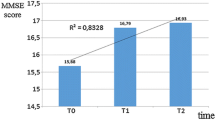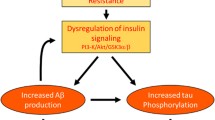Abstract
Background
Insulin resistance (IR) may play a role in most pathogenic processes that promote the development of Late Onset Alzheimer Disease (LOAD). This study was designed to determine the interaction between inhibition of both butyrylcholinesterase (BuChE) and acetylcholinesterase (AChE) with rivastigmine and peripheral insulin resistance (IR) in LOAD.
Methods
Seventy-Nine consecutive elderly patients, 31 late onset AD and 48 non-demented patients were evaluated. IR was calculated with HOMA. All of the patients were evaluated through comprehensive geriatric assessments at baseline and in the 6th and 12th months.
Results
End of the study, compared to the baseline values, there was a significant increase in the 6th month in both MMSE and IADL scores (t =2.200, p = 0.036 for MMSE and t =2.724, p= 0.011 for IADL, respectively). Rivastigmine was improved both the scores of MMSE and IADL in elderly patients with LOAD, but there was no significance or correlation between HOMA scores and cognitive status.
Conclusion
In conclusion, inhibition of both BuChE and AChE with rivastigmine was improved the cognition without affecting on the peripheral IR in the elderly patients with LOAD by HOMA. Due to the complexity of disease pathogenesis, it is too early to make general comments, and further longitudinal and long-term studies on this issue are needed.
Similar content being viewed by others
References
Isik AT, Bozoglu E: Insulin Resistance In Alzheimer Disease: Eds: Aucoin L, Prideux T: Handbook of Type 1 Diabetes Mellitus: Etiology, Diagnosis, and Treatment, Nova Science, Hauppauge NY, 2010 (ISBN: 978-1-60741-311-0).
Hoyer S: Glucose metabolism and insulin receptor signal transduction in Alzheimer disease. Eur J Pharmacol, 2004;490:115–125.
Watson GS, Craft S: The role of insulin resistance in the pathogenesis of Alzheimer’s disease: implications for treatment. CNS Drugs, 2003;17: 27–45.
Hoyer S: Is sporadic Alzheimer disease the brain type of non-insulin dependent diabetes mellitus? A challenging hypothesis. Journal of Neural Transmission, 1998;105:415–422.
Pilcher H: Alzheimer’s disease could be “type 3 diabetes”, Lancet Neurology, 2006;5:388–389.
Yaffe K, Kanaya A, Lindquist K, et al: The metabolic syndrome, inflammation, and risk of cognitive decline. JAMA, 2004;292:2237–2242.
Taubes G: Neuroscience. Insulin insults may spur Alzheimer’s disease. Science, 2003;301: 40–41.
Samochocki M, Zerlin M, Jostock R, et al: Galantamine is an allosterically potentiating ligand of the human alpha4/beta2 nAChR. Acta Neurol Scand Suppl., 2000;176:68–73.
Mesulam M: The cholinergic lesion of Alzheimer’s disease: pivotal factor or side show? Learn Mem, 2004;11:43–49.
Isik AT, Bozoglu E: Acetylcholinesterase Inhibition and Insulin Resistance in Late Onset Alzheimer Disease? Int Psychogeriatr, 2009;21(6):1127–1133.
Randel EW, Mathews MS, Zhang H, Seraj JS, Sun G: Relationship between serum butyrylcholinesterase and the metabolic syndrome. Clinical Biochemistry, 2005;38:799–805.
Matthews DR, Hosker JP, Rudenski AS, Naylor BA, Treacher DF, Turner RC: Homeostasis model assessment: insulin resistance and b-cell function from plasma fasting glucose and insulin concentrations in man. Diabetologia, 1985;28:412–419.
Isik AT, Cankurtaran M, Bozoglu E, Comert B, Doruk H, Mas MR: Is there any relation between insulin resistance and cognitive function in the elderly? Int Psychogeriatr, 2007;19:745–756.
Wilkinson DG, Francis PT, Schwam E, Payne-Parrish J: Cholinesterase inhibitors used in the treatment of Alzheimer’s disease: the relationship between pharmacological effects and clinical efficacy. Drugs Aging, 2004;21: 453–478.
Isik AT, Bozoglu E, Naharci MI, Eker D: Cardiac Safety of Rivastigmine in Patients with Late Onset Alzheimer’s Disease. Journal of Geriatrics and Geriatric Neuropsychiatry, 2010;1(3): 21–26.
Leibson CL, Rocca WA, Hanson VA et al:. Risk of dementia among persons with diabetes mellitus: a population-based cohort study. Am J Epidemiol, 1997;145:301–308.
Stolk RP, Breteler MM, Ott A et al: Insulin and cognitive function in elderly population. The Rotterdam Study. Diabetes Care, 1997;20:792–795.
Gasparini L, Netzer WJ, Greengard P, Xu H: Does insulin dysfunction play a role in Alzheimer’s disease? Trends in Pharmacological Sciences, 2002;23: 288–293.
Ho L, Qin W, Pompl PN et al: Diet-induced insulin resistance promotes amyloidosis in a transgenic mouse model of Alzheimer’s disease. The FASEB Journal, 2004;18:902–904.
Reyes AE, Chacón MA, Dinamarca MC, Cerpa W, Morgan C, Inestrosa NC: Acetylcholinesterase-Abeta complexes are more toxic than Abeta fibrils in rat hippocampus: effect on rat beta-amyloid aggregation, laminin expression, reactive astrocytosis, and neuronal cell loss. Am J Pathol, 2004;164:2163–2174.
Das UN: Acetylcholinesterase and butyrylcholinesterase as possible markers of low-grade systemic inflammation. Med Sci Monit, 2007;13:RA214–221.
Bigl M, Apelt J, Eschrich K, Schliebs R: Cortical glucose metabolism is altered in aged transgenic Tg2576 mice that demonstrate Alzheimer plaque pathology. J Neural Transm, 2003;110:77–94.
Houstis N, Rosen ED, Lander ES:Reactive oxygen species have a causal role in multiple forms of insulin resistance, Nature, 2006;440: 944–948.
Sharma P, Senthilkumar RD, Brahmachari V, et al: Mining literature for a comprehensive pathway analysis: A case study for retrieval of homocysteine related genes for genetic and epigenetic studies. Lipids Health Dis 2006;5:1.
Author information
Authors and Affiliations
Corresponding author
Rights and permissions
About this article
Cite this article
Isik, A.T., Bozoglu, E. & Eker, D. aChE and BuChE inhibition by rivastigmin have no effect on peripheral insulin resistance in elderly patients with Alzheimer disease. J Nutr Health Aging 16, 139–141 (2012). https://doi.org/10.1007/s12603-011-0095-4
Received:
Accepted:
Published:
Issue Date:
DOI: https://doi.org/10.1007/s12603-011-0095-4




